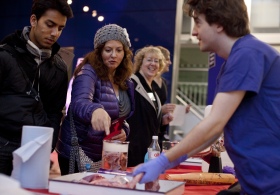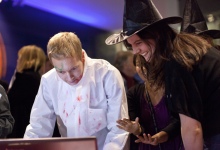Spooky Science

A report on the first of the Imperial Fringe events, which will provide staff and students with regular opportunities to try out public engagement .
Smoking marshmallows, a vibrant heart muscle and cobwebs galore – welcome to the Science Behind Our Fears event, held in the Main Entrance on 25 October. Reporter finds out more about the first of the Imperial Fringe events, which will provide staff and students with opportunities to try out public engagement throughout the year.
Last May, the Imperial Festival opened the College to thousands of members of the public for the first time and the subsequent evaluation revealed there was a huge appetite in the College to repeat this type of event on a more regular basis.
“Imperial Fringe aims to provide staff and students with a more informal platform to discuss their work and to encourage more members of the community to give public engagement a try,” explains Natasha Martineau, Head of Research Communications (Communications and Development).
Over the next six months the College will be holding Fringe events most months, drawing together research from across the College on topical themes, such as bones, or timely issues like last week’s on Halloween.
The Science Behind Our Fears event drew in around 350 visitors many of whom were young people. Events Officer Harriet Martin (Communications and Development) was really pleased with the turnout. “We really wanted to tap into the growing appetite for hands-on, science- related evening events that young people are flooding to across London,” she says.
Cryogenics and the end of the world
One of the most dramatic stalls of the evening was run by PhD student Leon Vanstone (Aeronautics), who was based on a tricycle with a white umbrella, decorated with small black skeleton heads. There, he demonstrated to staff, students and members of the public how to freeze and smash roses using liquid nitrogen, in order to explore the subject of cryogenics. Leon also fed visitors freshly iced marshmallows, which smoked when you crunched them.
Cryogenics is the concept of cooling legally-dead people to liquid nitrogen temperature (-210 °C) where physical decay essentially stops. Leon used his experiment to tackle the Halloween- appropriate topic of apocalypse; more specifically, ‘When the world is over, what can humans do next?’ One of the ideas is to use cryogenics to freeze and and transport people to a new star thousands of light years away to ensure the survival of the human race.
Leon explained to visitors that the technology for cryogenics isn’t yet possible because the effect of freezing on people’s internal membranes is not known. “I love doing live experiments and talking about the ethical questions of our research with members of the public,” says Leon.
Leon regularly gets involved in public engagement activities at the Natural History Museum, as well as helping out with homework clubs via the Outreach office at Imperial. “I really enjoy speaking to the public about the kind of things we do in the lab, and sometimes using crazy analogies to help show that complicated scientific theories are often quite simple.”
Educated at a state school, Leon thinks outreach work like this is particularly important. “I want to show school pupils that there is no reason why any of them couldn’t do a degree at Imperial – there is no mystery to it – you just need an interest in the world and be prepared to work hard.”
Can you die from fright?
 Brandishing a real pig heart procured from the local butcher, research postgraduates Pete Wright and Matt Tranter (NHLI) drew visitors to their stall where they discussed whether it is possible to ‘die from fright’.
Brandishing a real pig heart procured from the local butcher, research postgraduates Pete Wright and Matt Tranter (NHLI) drew visitors to their stall where they discussed whether it is possible to ‘die from fright’.
“People are well aware of the dangers of heart attacks,” says Pete, “but in our industrialised society, the average person is so far removed from the visceral that we wanted to give them the chance to actually feel the myocardium – the muscular tissue of the heart – and, in my opinion, the most amazing material in the universe!”
Pete and Matt both work in Professor Sian Harding’s group, with Pete using microscopy to consider how receptors in the heart are affected by stress and Matt looking at menopausal women who have suffered from cardiac arrest following stressful scenarios.
Although Matt had never had any experience of being involved in a public engagement activity like this before, Pete had volunteered at the Imperial Festival in May, where he talked to the public about cardiac stem cells. “These type of events take you out of the narrowly focused mindset of the lab and remind you how exciting what you are doing really is,” he explains. He recalls being asked some very bizarre questions, such as, “can we eat muscle grown from stem cells” and “is it a good food to take to space?”
Modelling a zombie outbreak
 The most contagious stall of the event was run by Junior Research Fellow Dr Deirdre Hollingsworth and Dr Wes Hinsley (both Public Health). Deirdre’s role at Imperial is to build computer models of how infectious diseases are transmitted, to help inform policy during an outbreak such as the swine flu epidemic in 2009. Wes provides high performance computing support for academics and, as a postdoctoral researcher at Imperial, developed some computer modelling software called the Global Epidemic Simulator.
The most contagious stall of the event was run by Junior Research Fellow Dr Deirdre Hollingsworth and Dr Wes Hinsley (both Public Health). Deirdre’s role at Imperial is to build computer models of how infectious diseases are transmitted, to help inform policy during an outbreak such as the swine flu epidemic in 2009. Wes provides high performance computing support for academics and, as a postdoctoral researcher at Imperial, developed some computer modelling software called the Global Epidemic Simulator.
At the event, the team used a greatly simplified interactive version of the global simulator to show the behaviour of an infectious outbreak of Halloween-esque figures such as zombies, werewolves, witches and vampires. The specific characteristics of a disease, along with people’s mobility and any intervention policies applied, are key factors in predicting the spread of real outbreaks.
Deirdre explains the theory of the simulation: “Zombies are infectious when they are symptomatic – you can easily spot a zombie. So if you can isolate everyone who looks like a zombie you can control a zombie outbreak.” Wes goes on to explain how werewolves have seasonal behaviour in that at certain times of the year, they make more ‘contacts’ than at other times. This behaviour is comparable to influenza, which people in the UK most commonly catch in autumn, perhaps due to the social effects of the previous school holidays, or to the change in weather.
In addition to showing visitors the computer model, Deirdre also concocted a simulated epidemic at the event – getting volunteers to infect unsuspecting visitors with ‘infection cards’. Those infected had to go up to the stall where their ageband and the time was fed into a computer, with real-time data analysis projected onto the wall. They were then invited to roll a dice and then infect that number of other people to propagate the epidemic. “By the end of the event we had 136 cases, mainly in 20–30 year olds”
Both Deirdre and Wes hope the exercise will help people gain more of an understanding about media coverage of epidemics. “When the swine flu epidemic hit, there was a lot written in the media about it, but there wasn’t much about the dynamics of outbreaks,” says Deirdre. “I hope from our demos that people will gain an awareness that there are scientists who model outbreaks and carefully consider the effectiveness of interventions based on the likely characteristics of the disease.”
Continuing with the zombie theme, visitors to the event also had the chance to enjoy talks by Frank Swain, science writer and broadcaster, who is currently writing How to make a Zombie: the real life (and death) of science reanimation and mind control.
Stephen Roberts, Acting Head of Face-to-Face Learning at the Natural History Museum, was one of the many visitors to enjoy the first Fringe event. “It was a delight to see so many enthusiastic conversations taking place and such a vibrant atmosphere,” he says. “These Thursday nights will be another excellent addition to the increasingly rich cultural landscape that we all enjoy on and around Exhibition Road – I am looking forward to the next one.”
Pop along to the next Fringe event, Cutting close to the bone, on 29 November 17.30–21.00 in the Main Entrance.
Hear interviews from the Science Behind Our Fears event in Imperial's latest podcast
Article text (excluding photos or graphics) © Imperial College London.
Photos and graphics subject to third party copyright used with permission or © Imperial College London.
Reporter
Press Office
Communications and Public Affairs
- Email: press.office@imperial.ac.uk
